Study Shows Canada’s Efficiency Resource Potential
5 charts showing what happens if we maximize energy efficiency in Canada
June 14, 2018
Brendan Haley
Policy Director
Efficiency Canada
Last month, the International Energy Agency (IEA) and Natural Resources Canada released a study of Canada’s energy efficiency potential. This is a landmark study that helps demonstrate why energy efficiency can be Canada’s “first fuel”. The energy we save could account for more than 40% of Canada’s energy needs by 2050 if we start prioritizing new policies that improve energy efficiency today.
These types of studies estimate the amount of energy savings available and how they are distributed amongst sectors and over time (in this case, it takes a national perspective, looking out to 2050). The study uses the IEA’s World Energy Model which creates the World Energy Outlook. A “Current Policies Scenario” establishes a baseline of the Canadian energy system under policies currently enacted. This includes some existing efficiency initiatives such as Energy Star labeling, provincial energy efficiency programs, and Natural Resources Canada’s Energy Efficiency for Industry program. The study then outlines a Canadian “Energy Efficiency Scenario” that includes new policies such as:
- Net zero energy ready model building code by 2030 with nearly 100% compliance by 2050
- Building envelope upgrades and adoption of heat pumps to cut space heating intensity by 85% by 2050
- The highest efficiency standard for electric motor systems by 2025 and adoption of variable speed drives
- Stringent fuel economy standards for light and heavy-duty vehicles and incentives for hybrid and electric vehicle adoption
- Use of solvent-based technologies in unconventional oil production
What happens if we maximize Canada’s efficiency potential?
1) Energy Demand Decreases from Today’s Levels
The report demonstrates the difference between the path we are currently on versus a future where energy efficiency becomes a major policy priority. As shown in the chart below, under the “Current Policies Scenario” energy demand continues to increase, while an extra 100 million tonnes of oil equivalent (Mtoe) in primary energy demand is saved in the Energy Efficiency Scenario in 2050. That is more than the total contribution of oil resources in 2016 (about 1/3 of 2016’s final energy demand).
Total Primary Energy Demand (PRED) and Total Final Consumption (TFC) in Current Policies versus Energy Efficiency Scenario
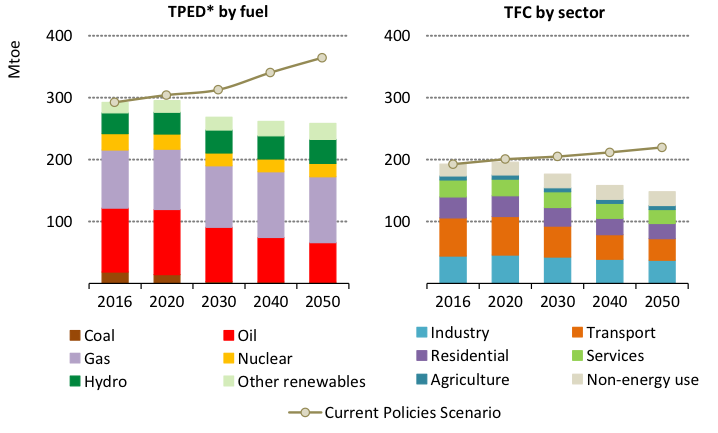
Energy Efficiency Potential in Canada, Figure 2
2) Savings in all sectors, led by buildings and transport
As shown in the next chart, the biggest energy savings come from buildings (28%) and transport (25%), and then oil and gas extraction (21%) and industry (12%). Savings in the power sector more than offset increased electrification from heat pumps and electric vehicles, which decrease energy demand in other sectors. With improved energy efficiency the federal government can hit its 2030 target for coal phase-out and Canadian electricity systems significantly reduce the need to build new gas-fired power plants.
Avoided energy demand owing to energy efficiency measures in the Current Policies Scenario and the Energy Efficiency Case, 2050
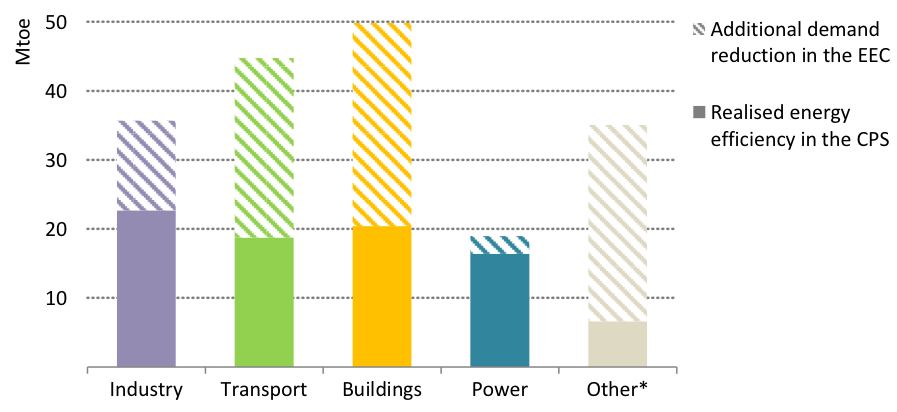
Energy Efficiency Potential in Canada, Figure 1
3) Energy Bills Decrease
Increased energy efficiency also creates a big reduction in household energy costs. The figure below shows that the average Canadian household would only spend 2.2% of gross household income on energy (housing and transportation) in 2050 in the Energy Efficiency Scenario, compared to 5.1% in 2016. Ensuring Canadians with lower incomes participate in energy savings opportunities could help end energy poverty in Canada.
Energy expenditure as a percentage of total household income in selected regions in the Current Policies Scenario and the Energy Efficiency Case for Canada
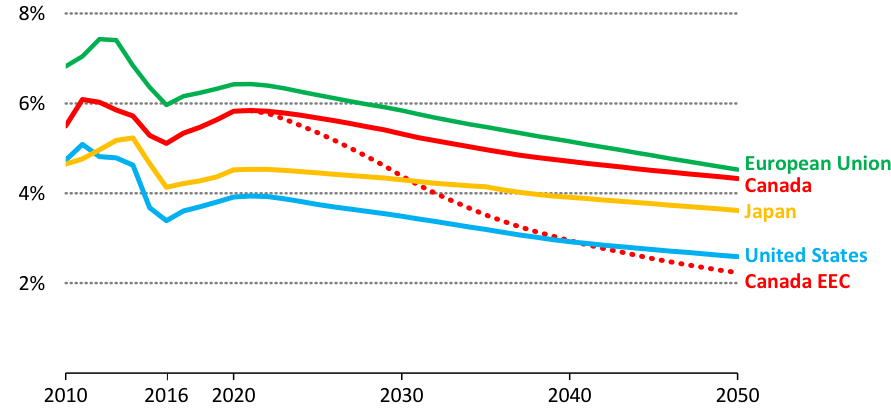
Energy Efficiency Potential in Canada, Figure 23
4) Efficiency offsets demand from a booming oil and gas sector, improving the sector’s competitiveness
Finally, note that the “Current Policies Scenario” baseline used in the study sees a major boom in Canadian oil and gas production, because of high global oil prices (154 USD/barrel in 2050) and demand for Canadian exports. Energy efficiency can significantly reduce the energy demands that come with increased oil and gas extraction, as shown in the chart below. This increases Canada’s net fossil fuel trade balance as fewer energy inputs are used to produce the same output, and Canada’s exports become more internationally competitive.
Change in own-use energy demand for selected energy supply and transformation sectors in Canada, in the Current Policies Scenario and the Energy Efficiency Case, 2016-2050
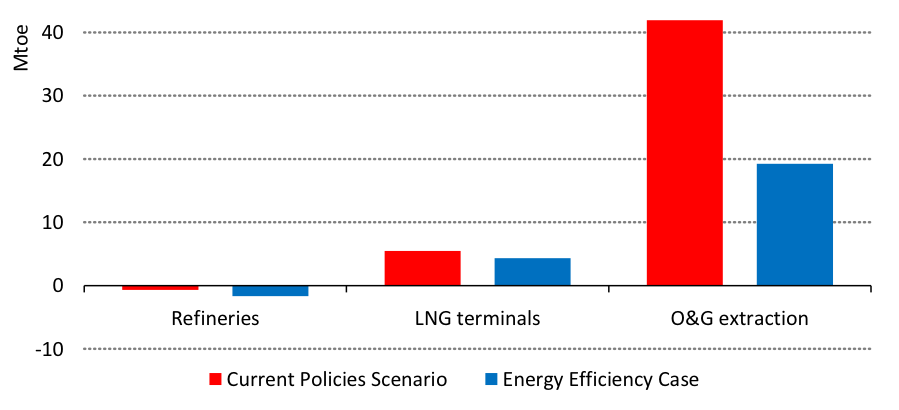
Energy Efficiency Potential in Canada, Figure 20
5) GHG Emissions Decrease
Even with this boom in oil and gas extraction, greenhouse gas emissions fall considerably because of energy efficiency, as shown in the next chart. Under the Energy Efficiency Scenario GHG emissions are reduced by 255 million tonnes in 2050. These savings could make up 30-40% of the reductions required to reduce emissions 80% below 2005 levels by 2050.[1]
CO2 emissions in Canada from fuel combustion by scenario
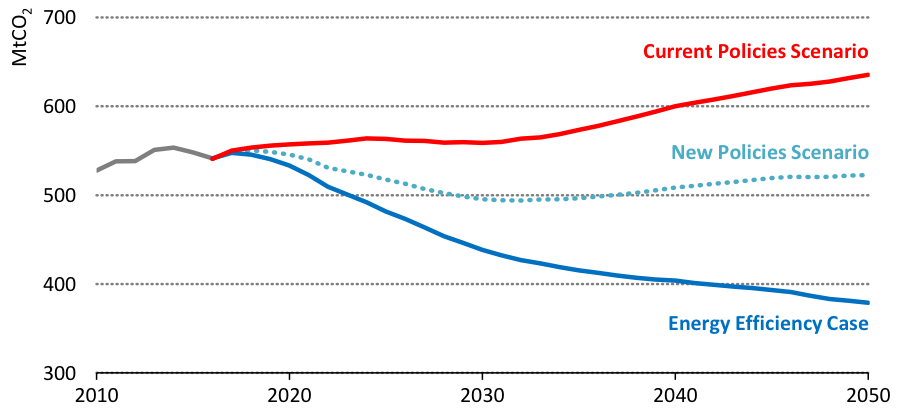
Energy Efficiency Potential in Canada, Figure 25
What is not in the Study?
The study does not consider the influence of technological changes such as digitization or autonomous vehicles. Not accounting for the savings of new technologies likely underestimates the energy savings potential, as well as important dynamics that can shift energy demand baselines up or down. Previous experience teaches us that many energy savings opportunities were not predicted even a few years before they appeared, and thus considering the role of new technology is needed to hit big energy savings. One way to account for the evolution of technologies and new energy end uses is to ensure estimating efficiency potential becomes a regular occurrence, so we hope this efficiency potential study is only the beginning, and that the federal government regularly updates efficiency potential in future years.
The study also excludes consideration of structural or behavioural changes, such as urban and housing densification, the move towards higher value light industries, or mobility shifts through biking, teleworking etc. A recent Canadian study in the Journal of Energy Efficiency shows these influences can be very important. We are also seeing new program designs that change energy saving behaviours by using strategic rewards, making energy use visible, and giving end users greater control over their energy usage, that could further increase energy savings.
How do we Harness Canada’s Energy Efficiency Potential?
This study demonstrates the huge contribution efficiency needs to make for Canada to meet climate commitments, maintain competitiveness, and improve energy affordability. Efficiency is a large resource, on a par with oil and gas, electricity, and renewable energy. It deserves to be treated as Canada’s “first fuel” and become top of mind with policymakers and energy system managers.
Many of the policies that see us reaching the “Energy Efficiency Scenario” are currently proposed, but not yet implemented. This includes building energy labelling, a net-zero energy ready building code, and more efficient minimum energy performance standards for appliances and equipment.
Reaching these higher levels of energy savings also required ramping up efforts in provincial and utility energy systems. Finer scale efficiency potential studies of provincial and utility energy systems will be important to demonstrate that efficiency is most often a lower cost option compared to power plants and fossil fuels. Efficiency potential studies could also guide how best to spend carbon pricing revenues.
Note that our recent study showed that ramping up to levels of energy savings that are shown to be achievable in leading jurisdictions could create 118,000 net jobs per year, on average between now and 2030. So, exploiting this efficiency potential will help build the energy efficiency industry and boost the national economy.
So let’s get on with taking advantage of the abundant, cost-effective, and accessible energy resource called energy efficiency! We are building Efficiency Canada to advocate just for that! Come join us in this common mission!
[1] Based on Current Policy Scenario fuel combustion emissions and holding emissions from non-fuel combustion constant at 2016 levels in 2050, or 2050 BAU emissions levels baseline from the Pembina Institute’s Energy Policy Simulator.

